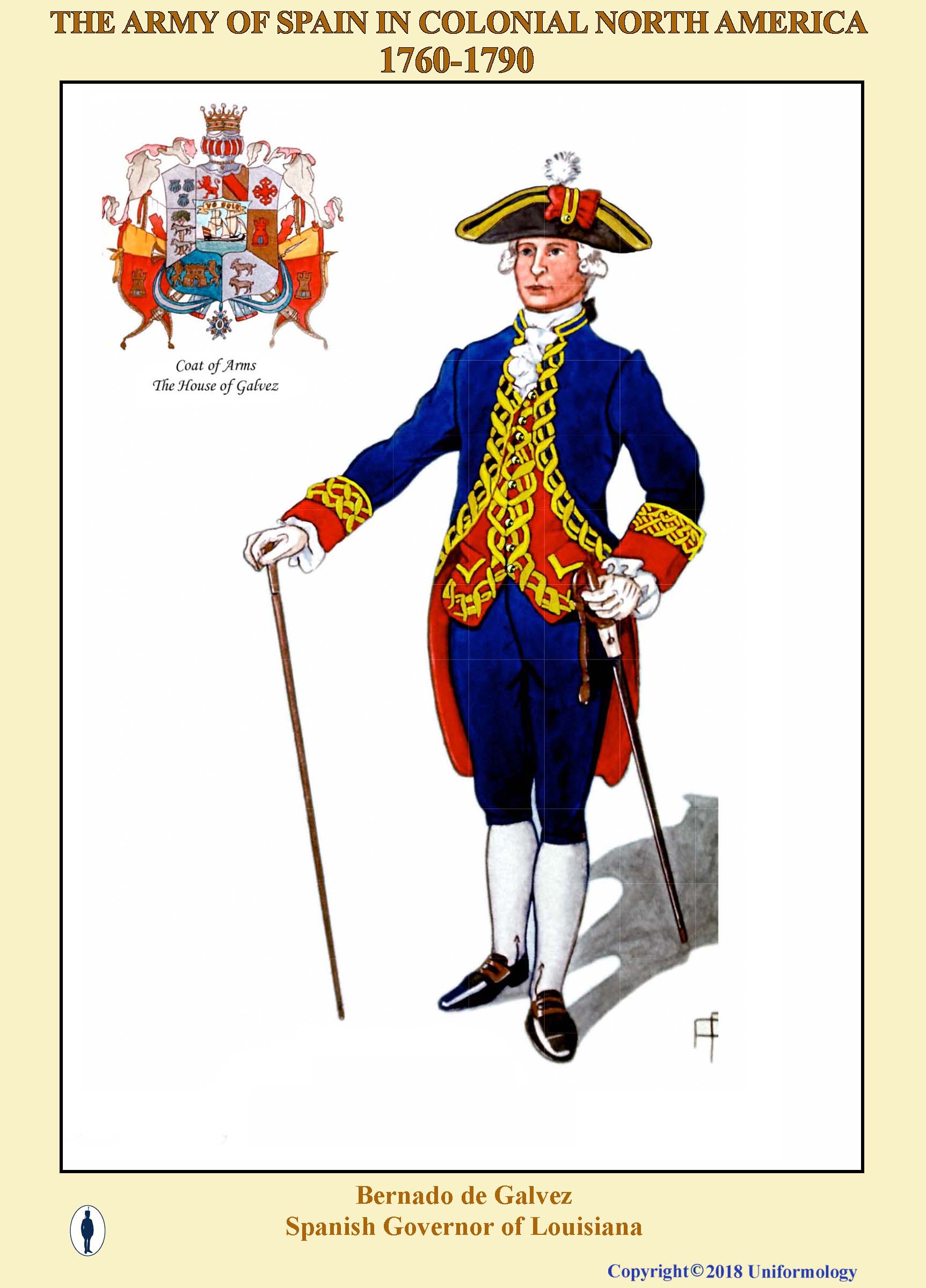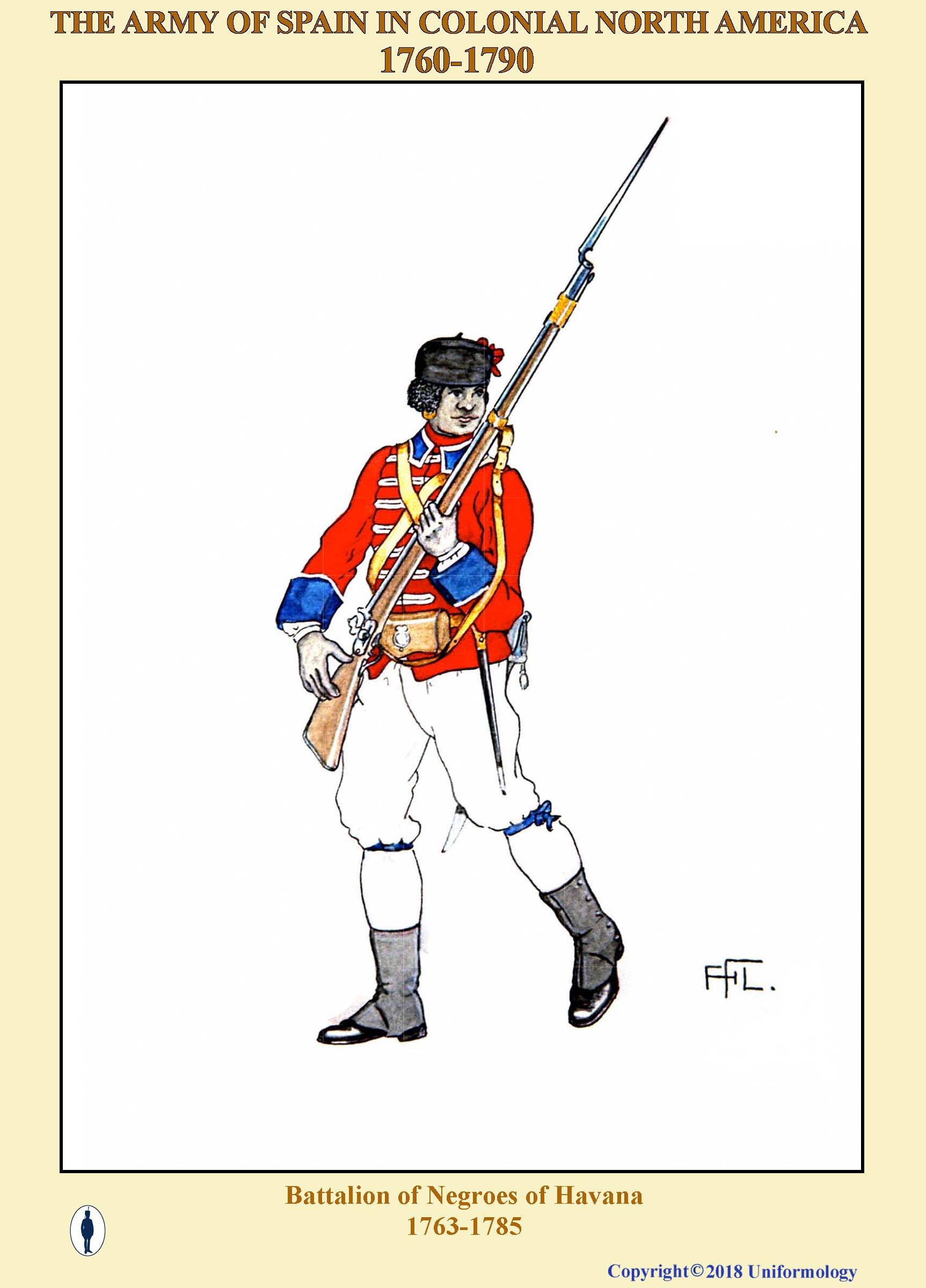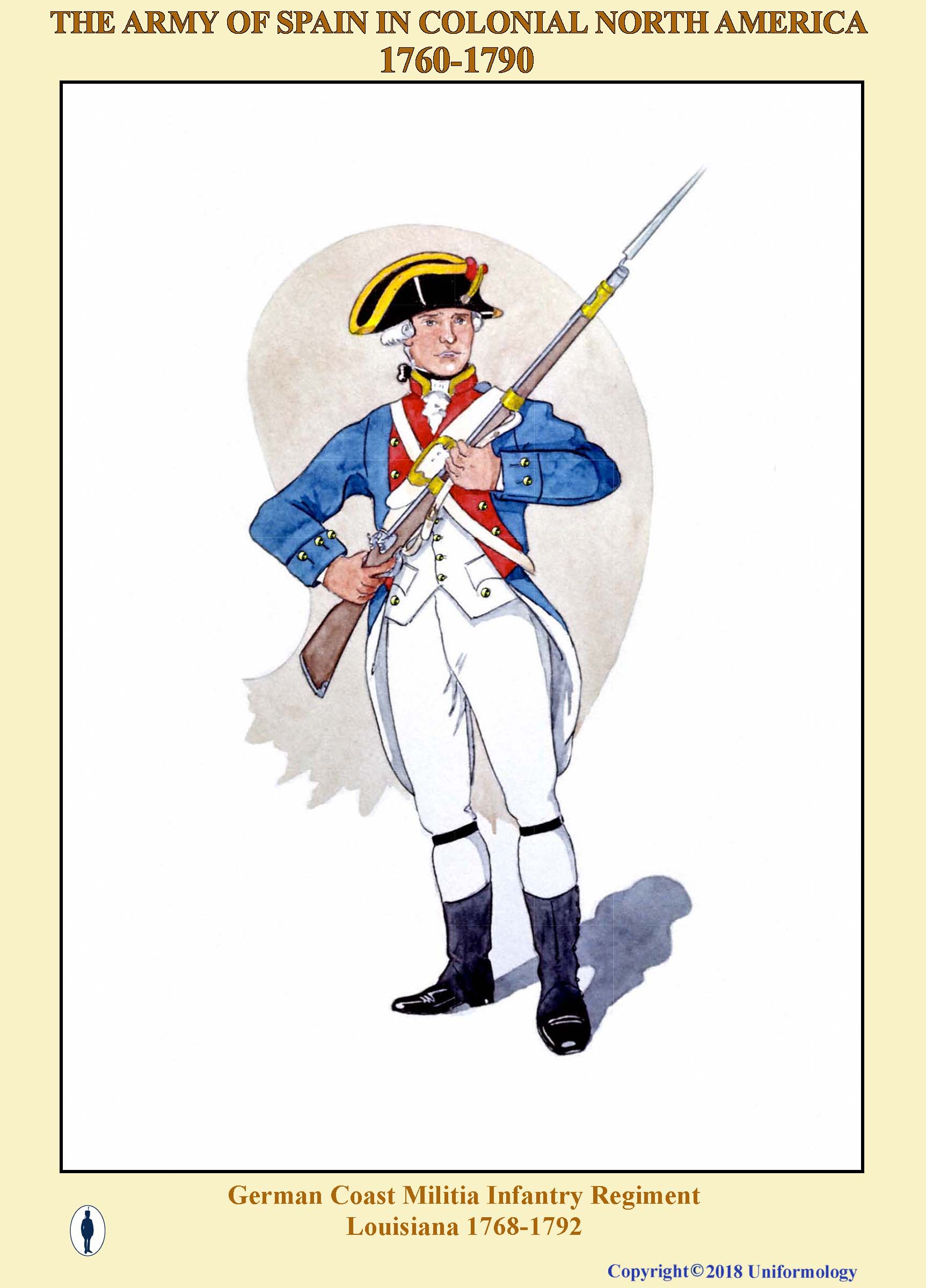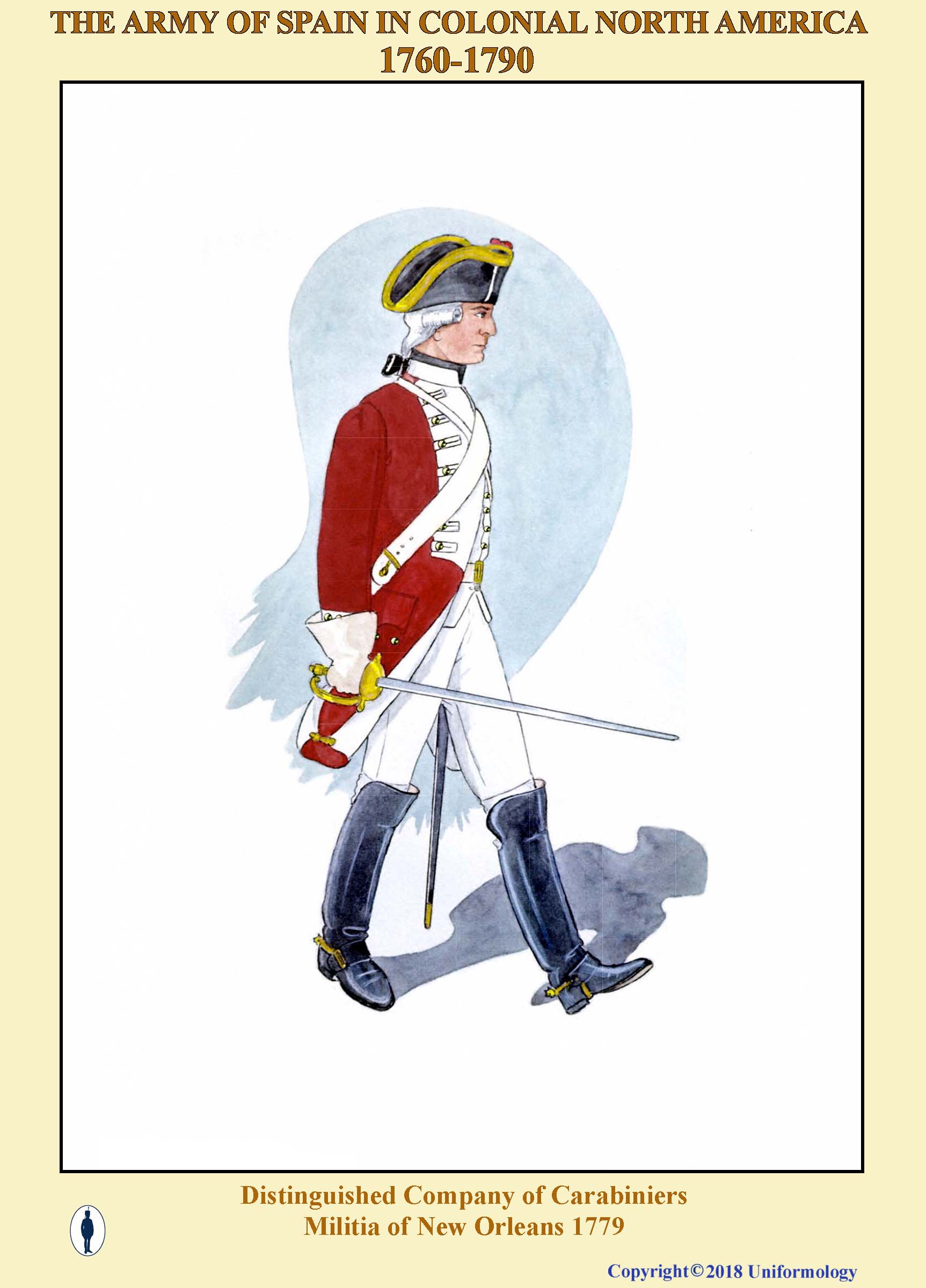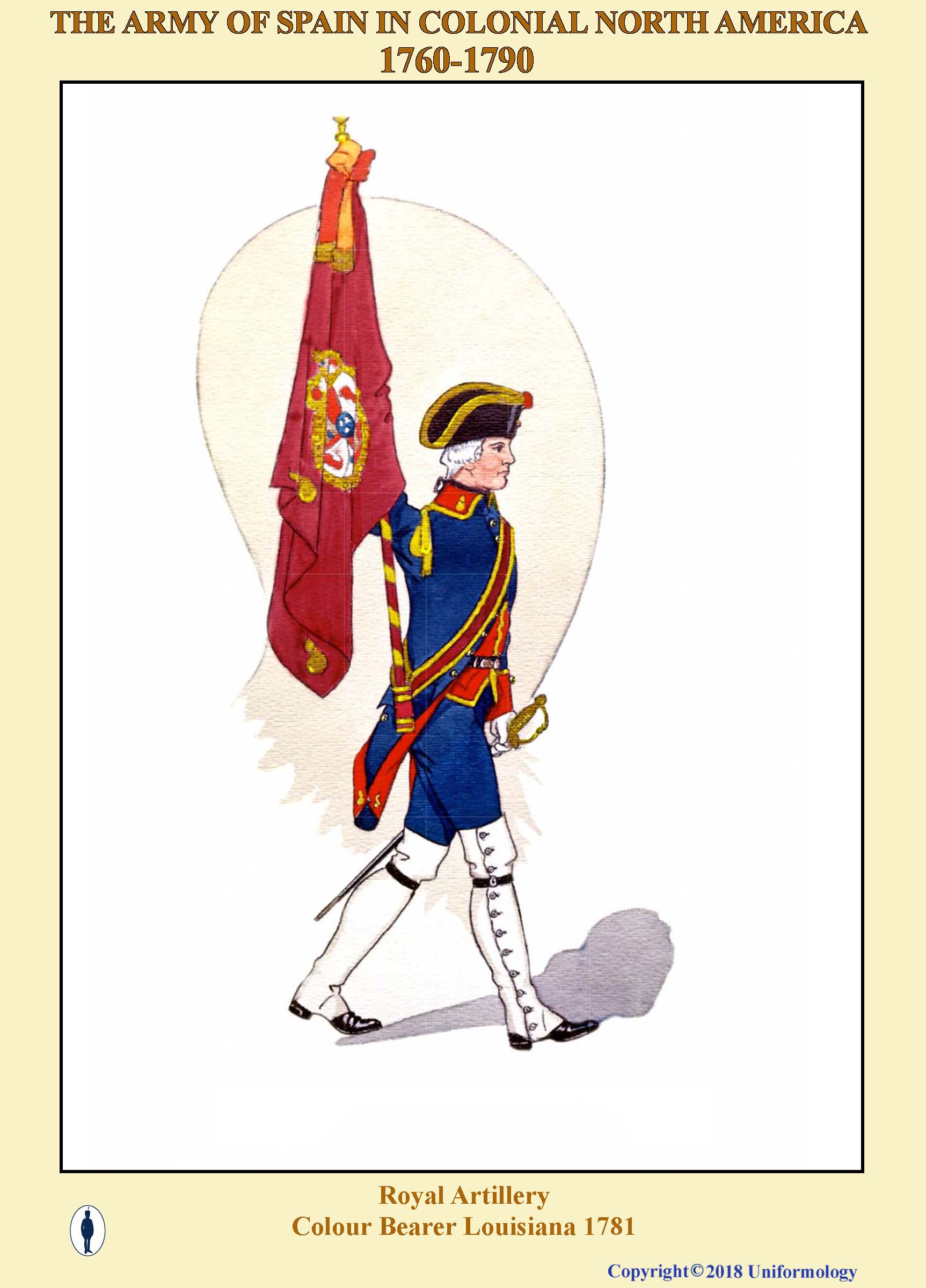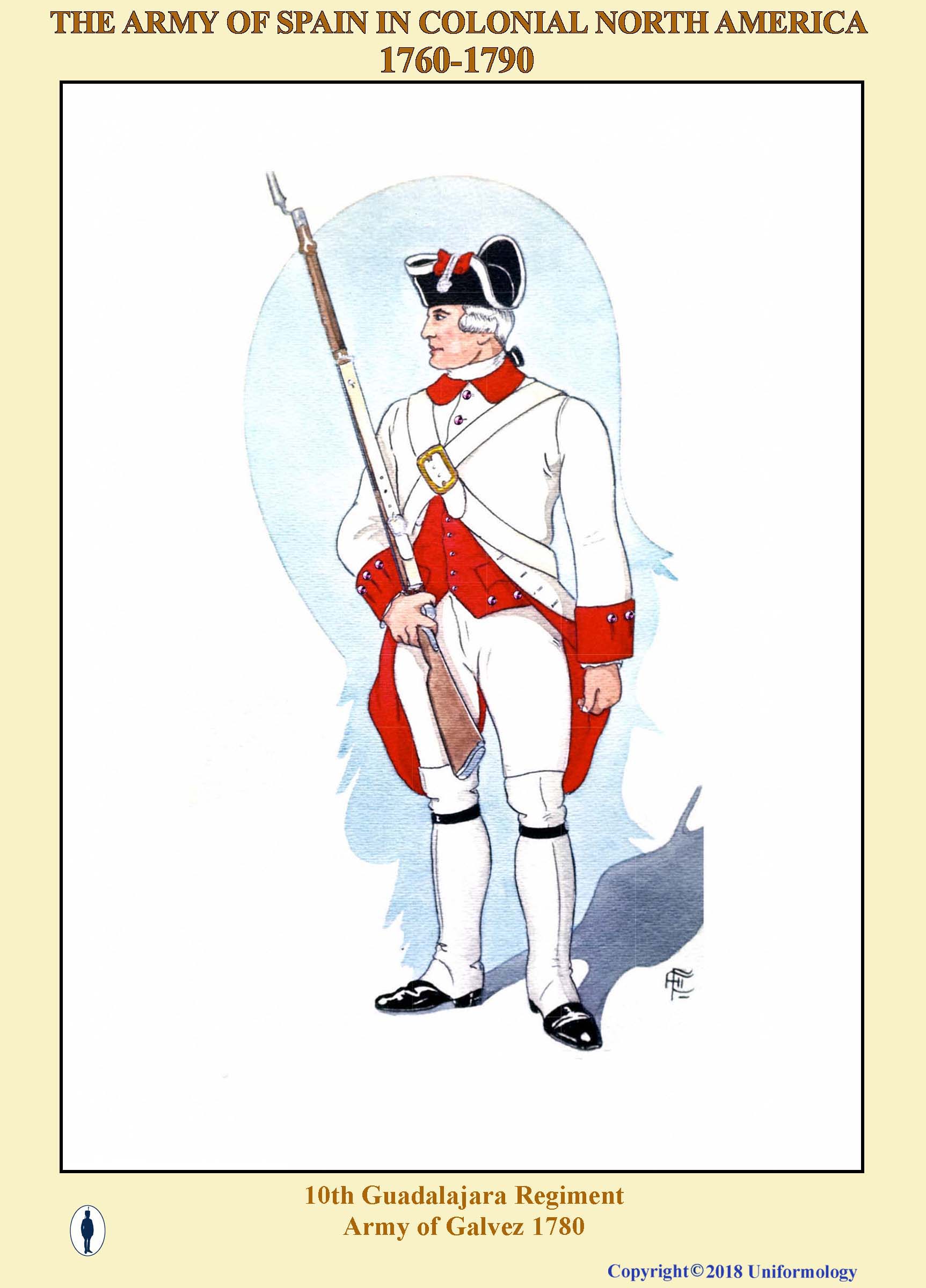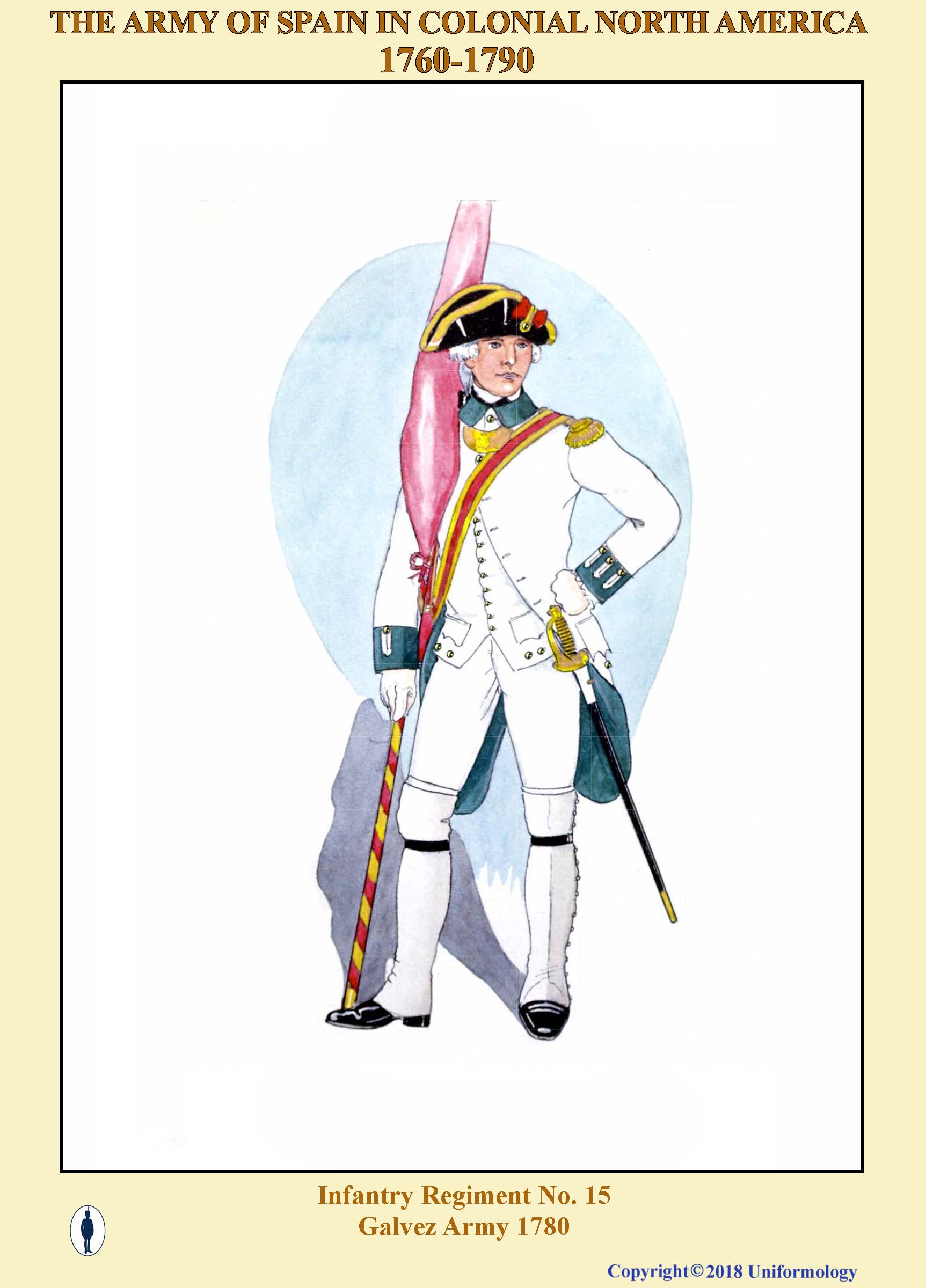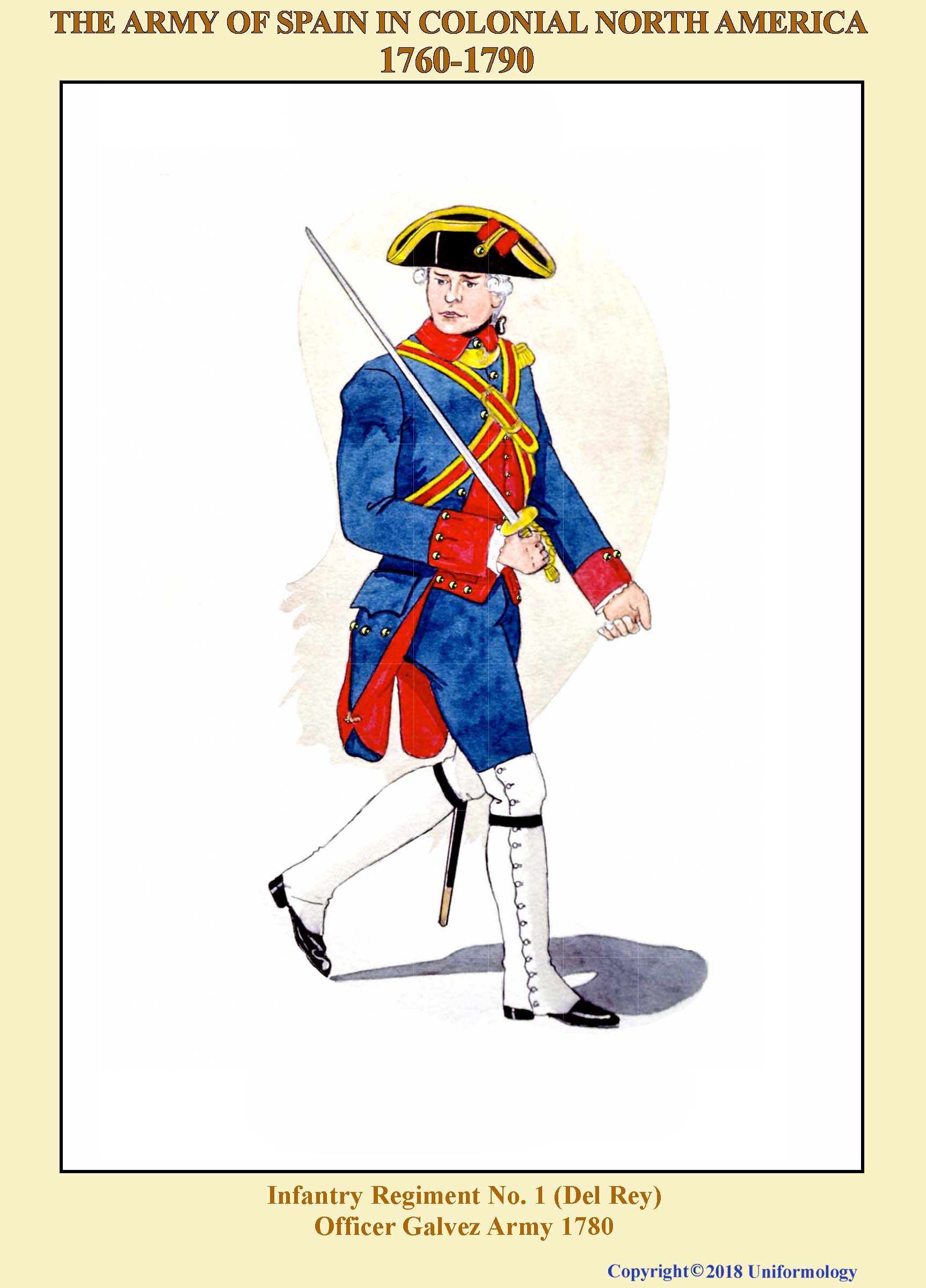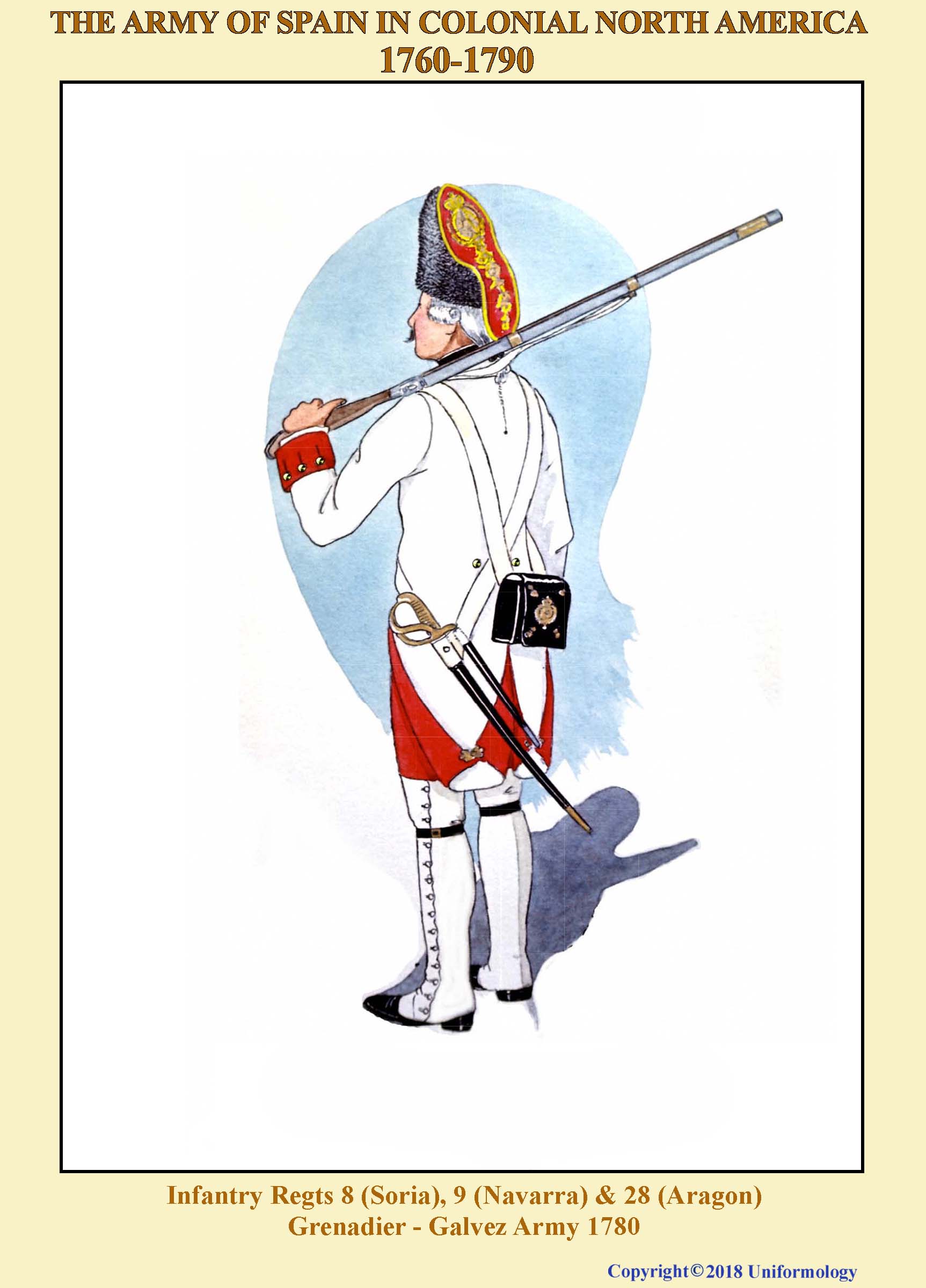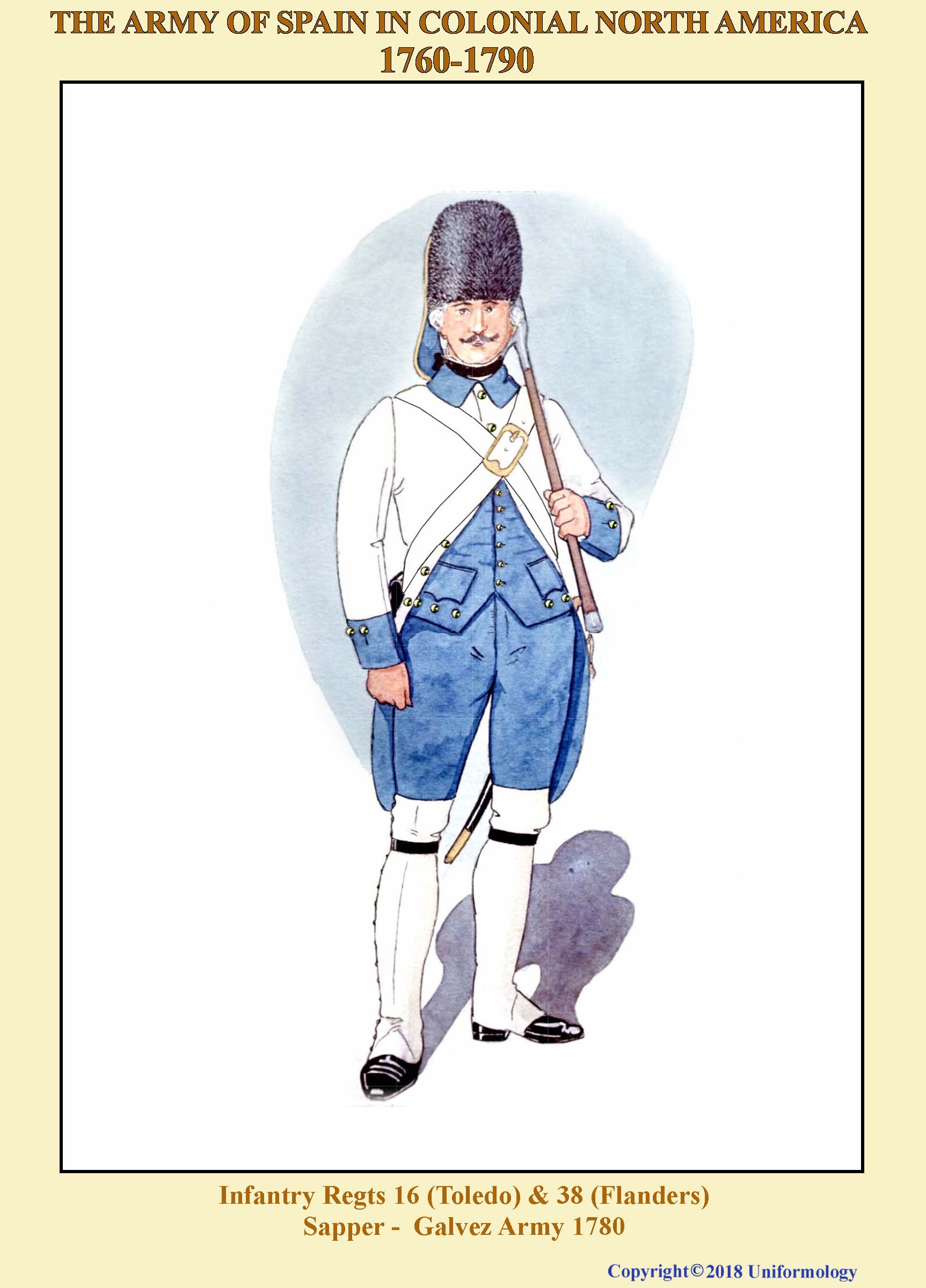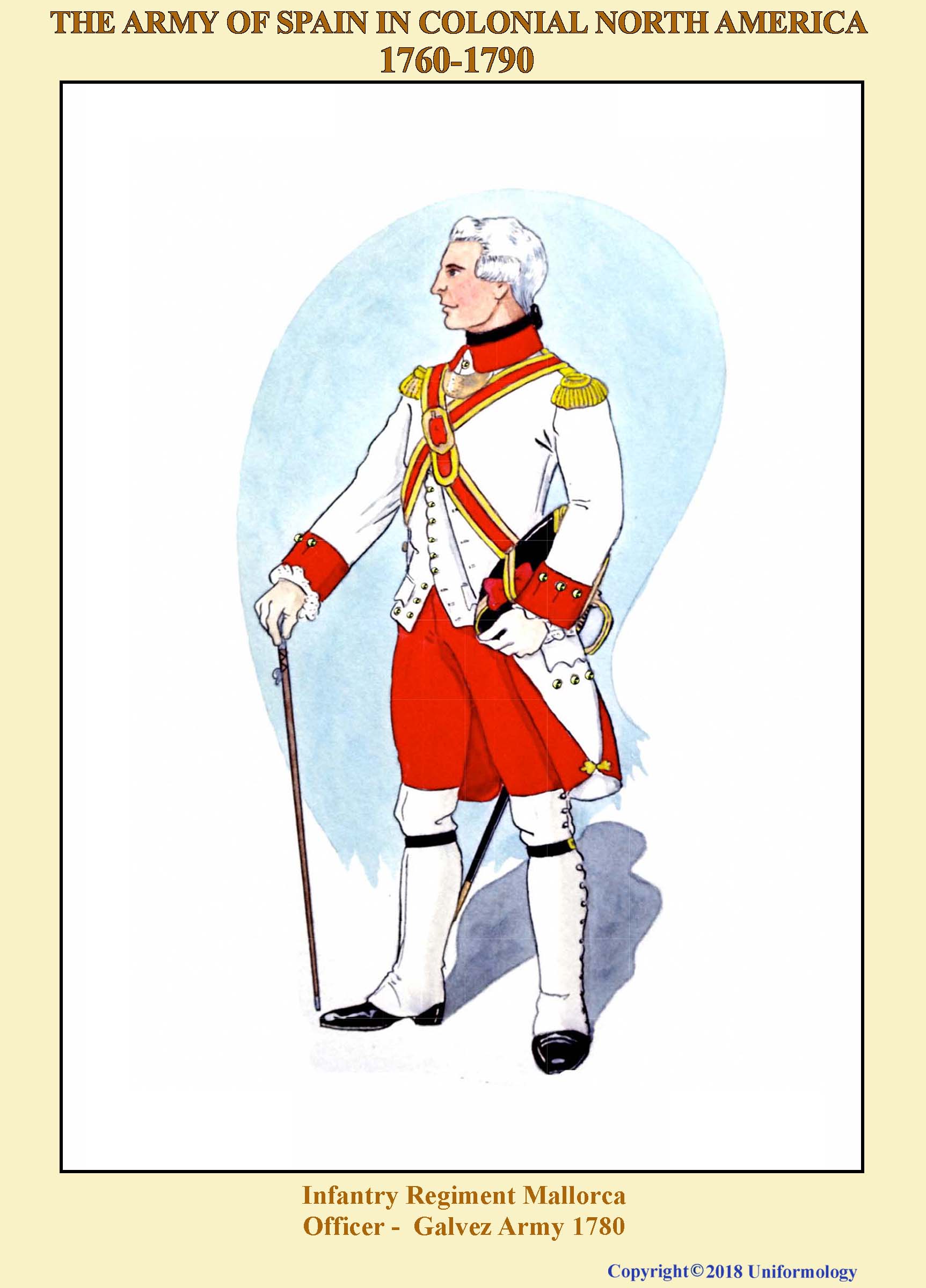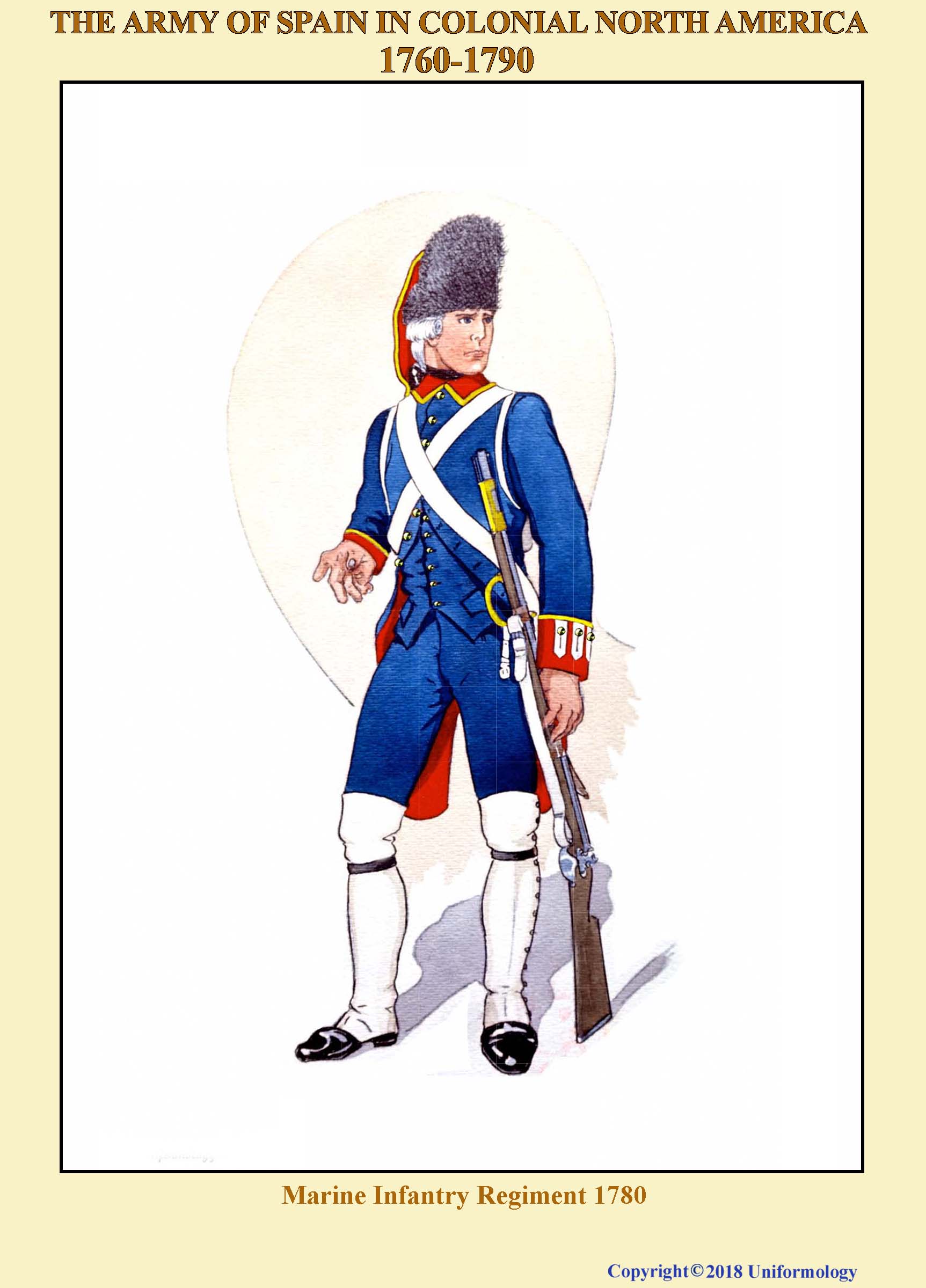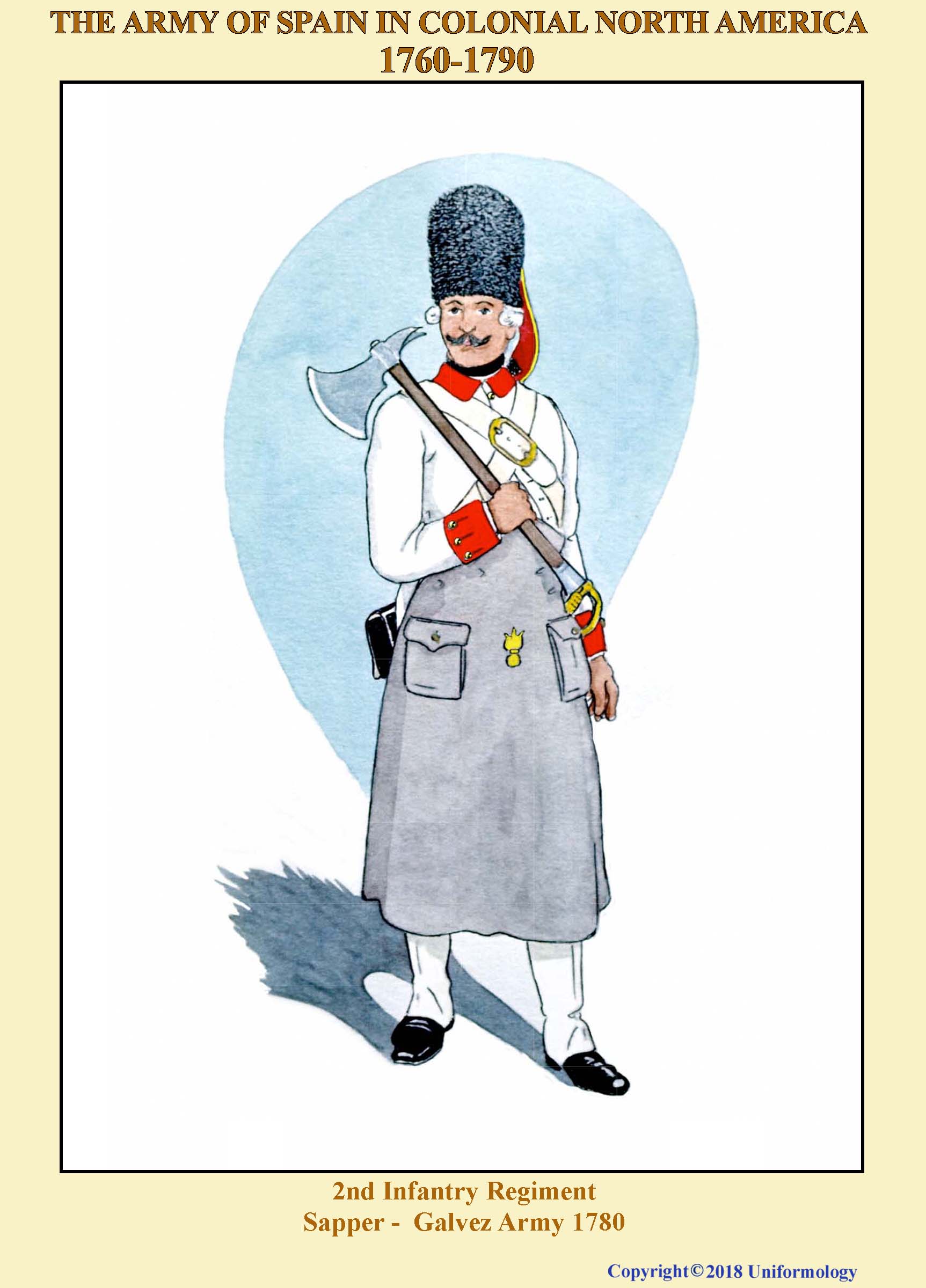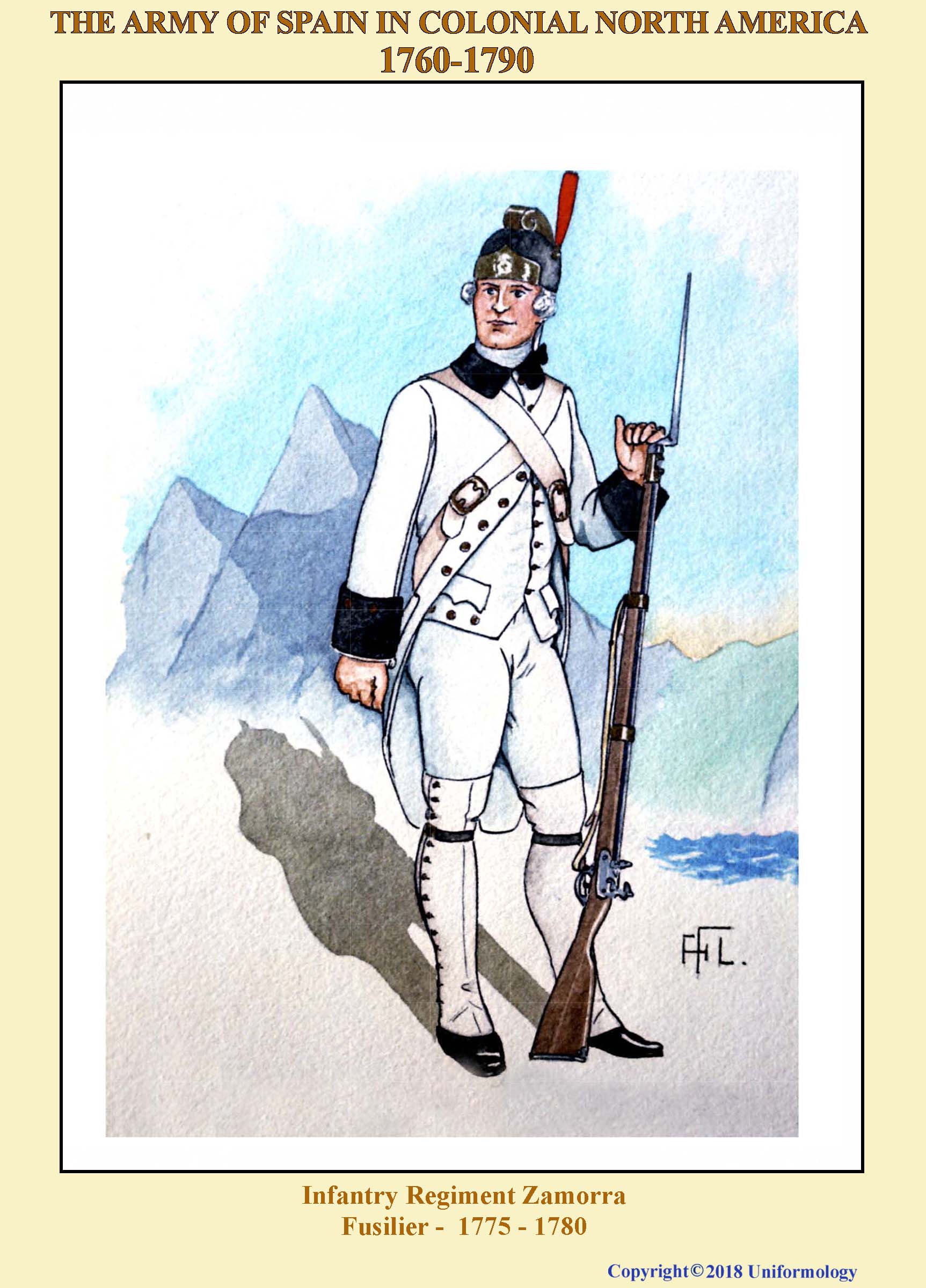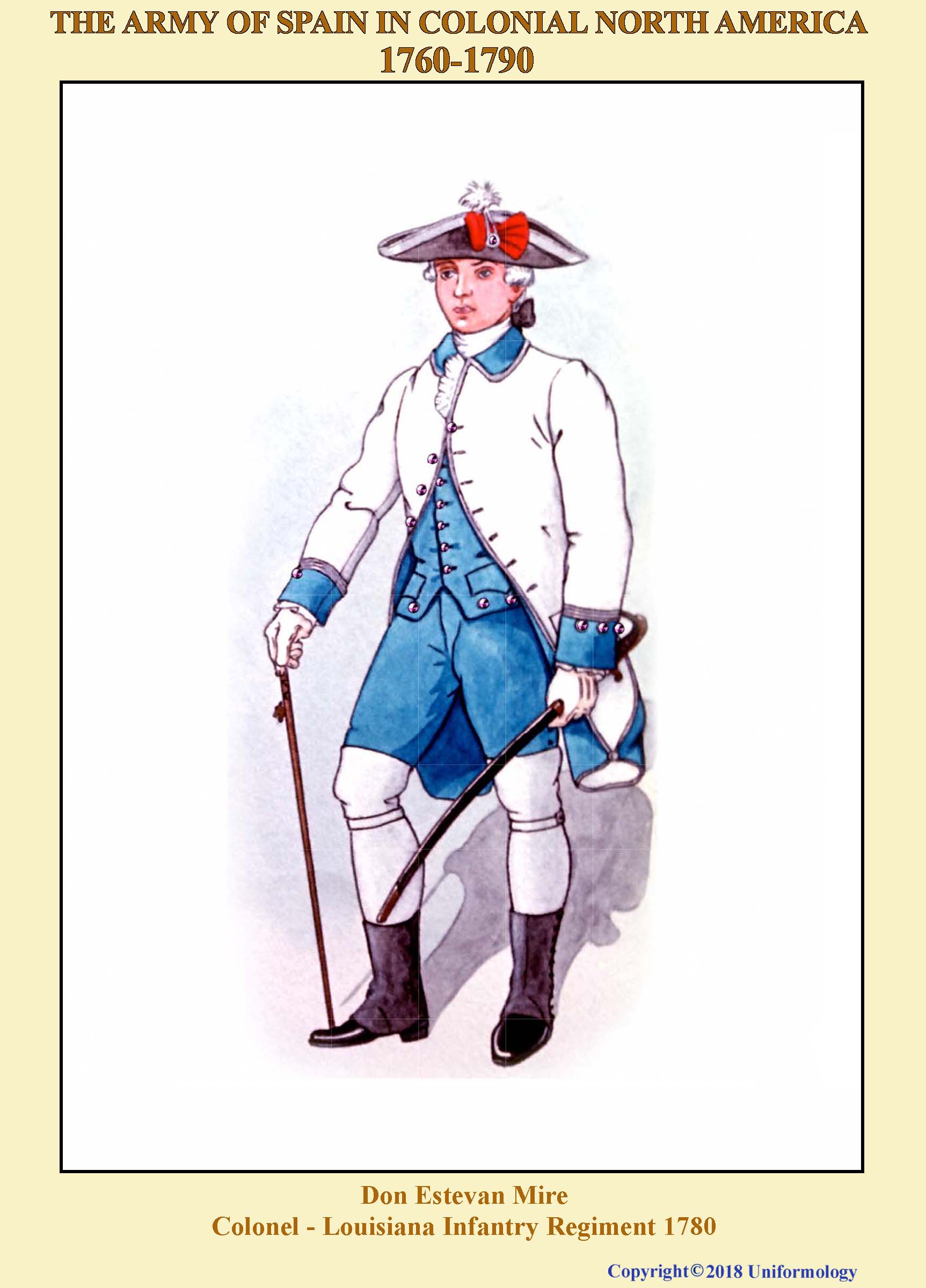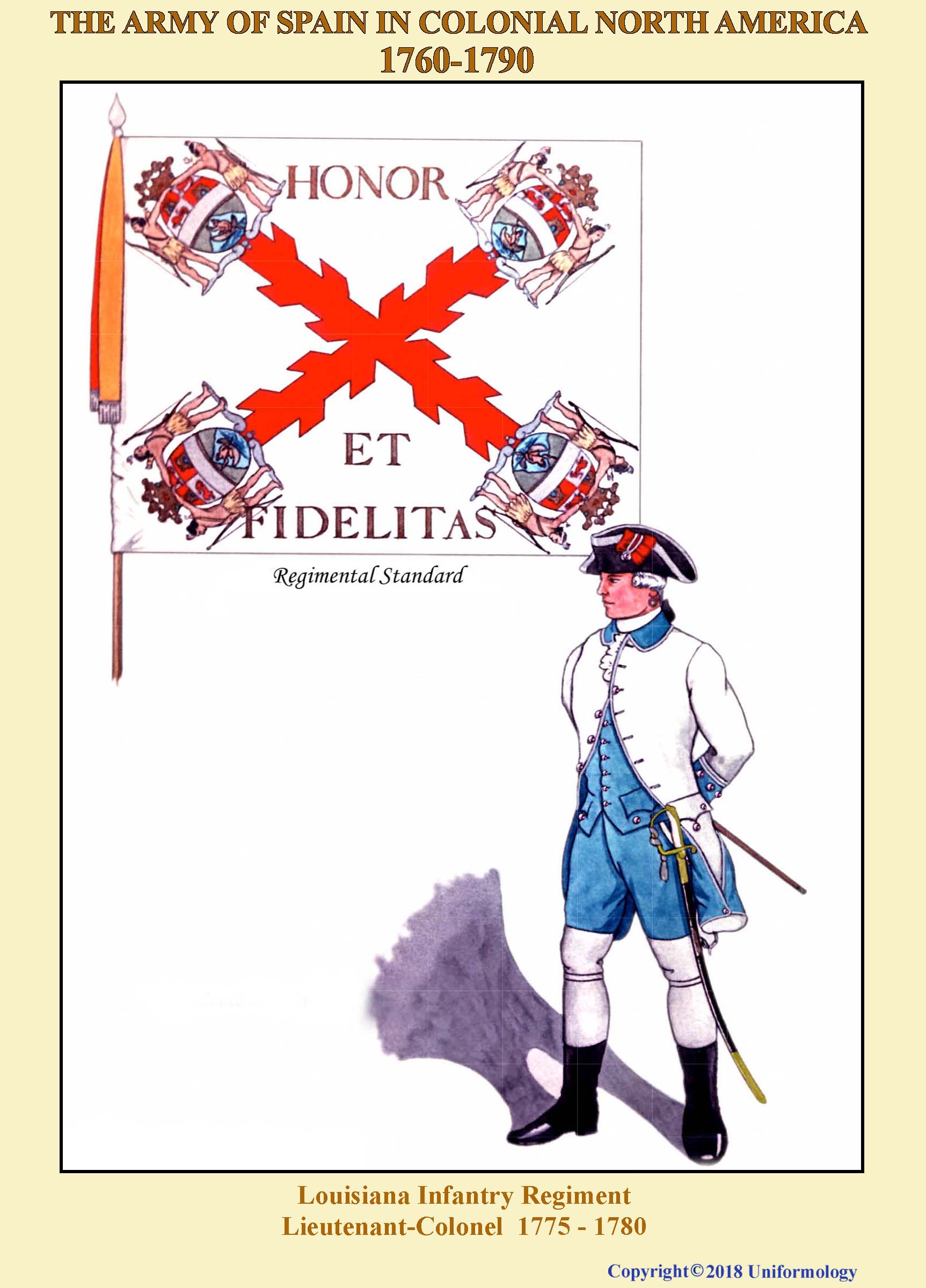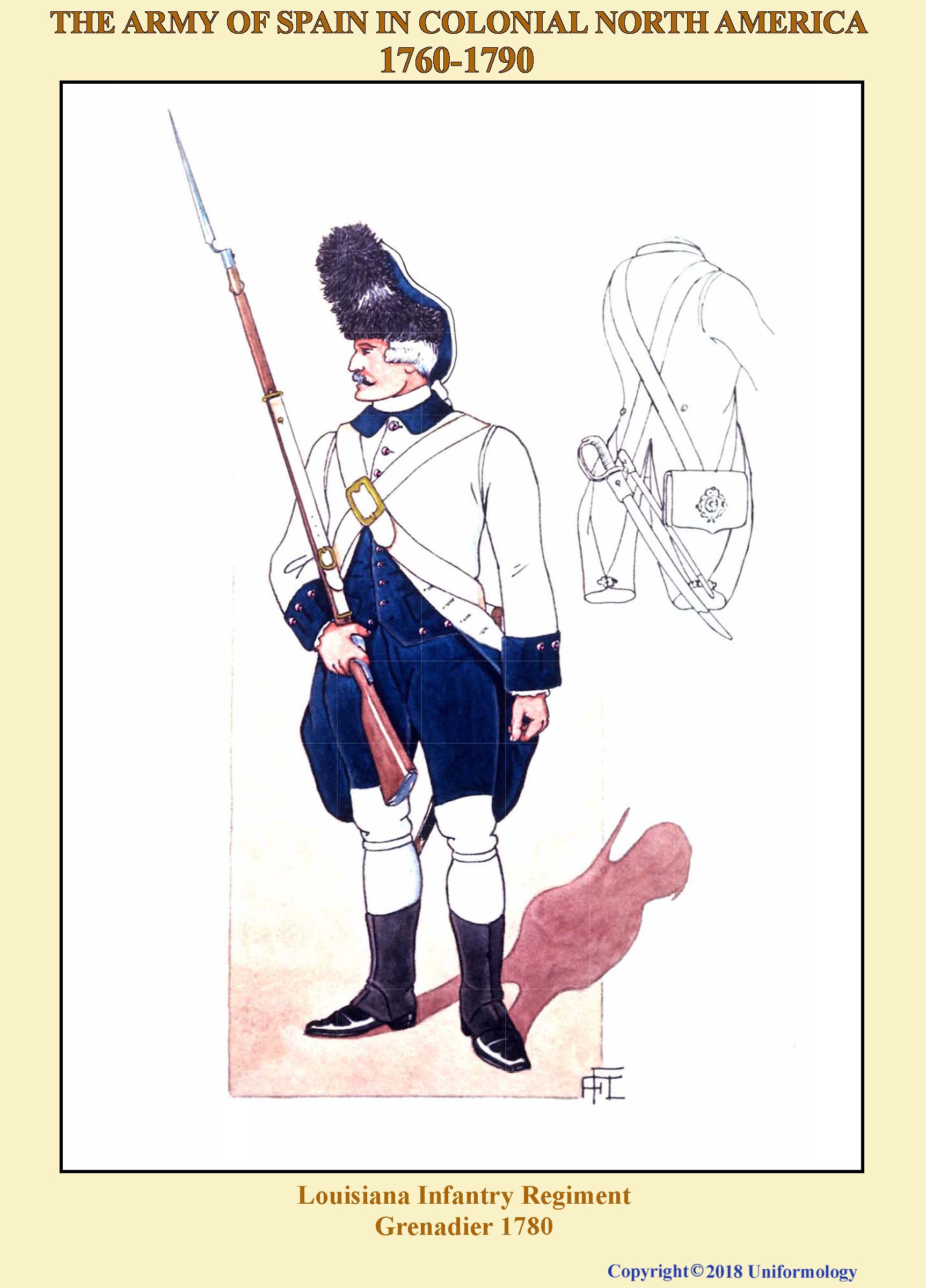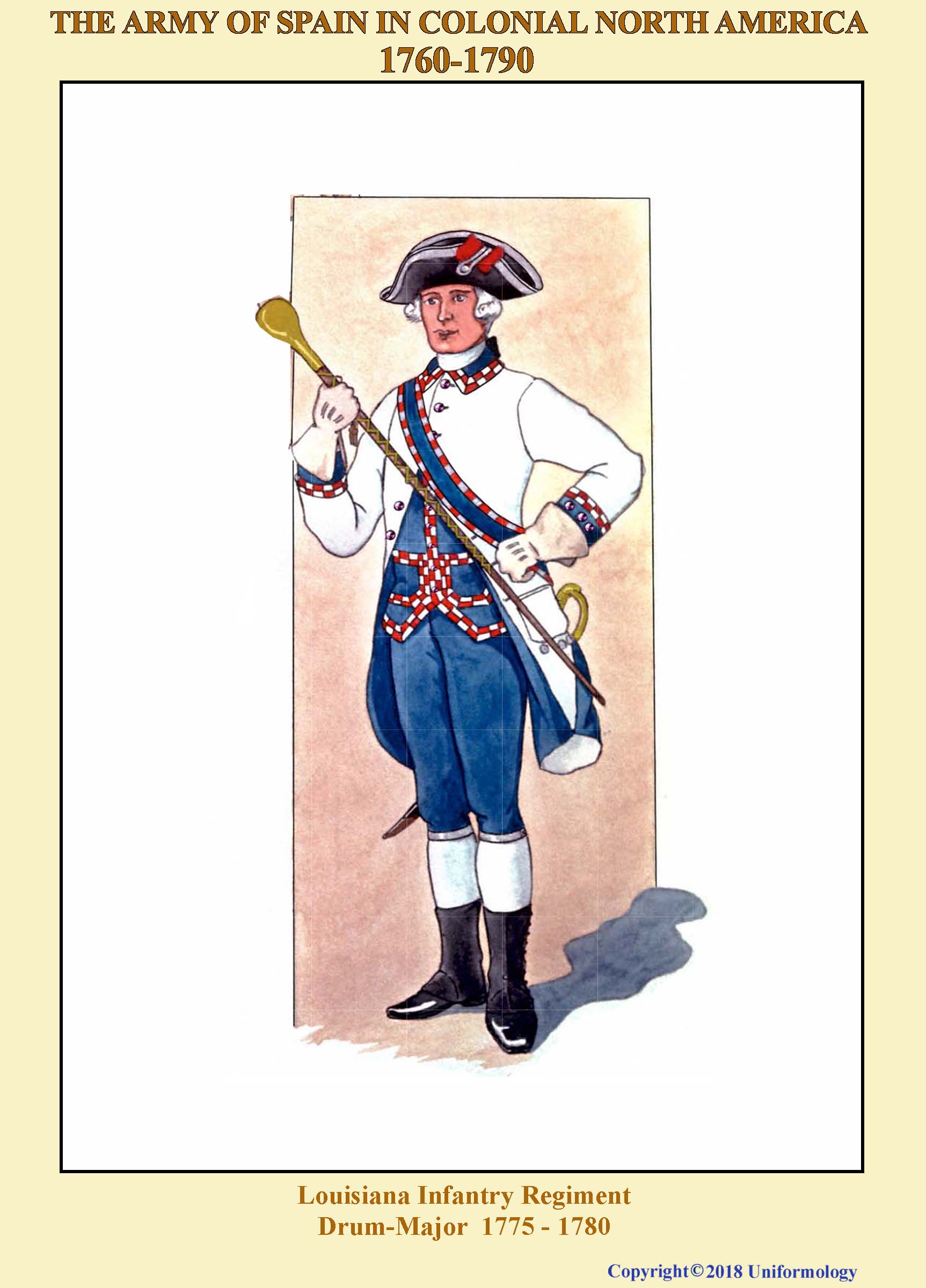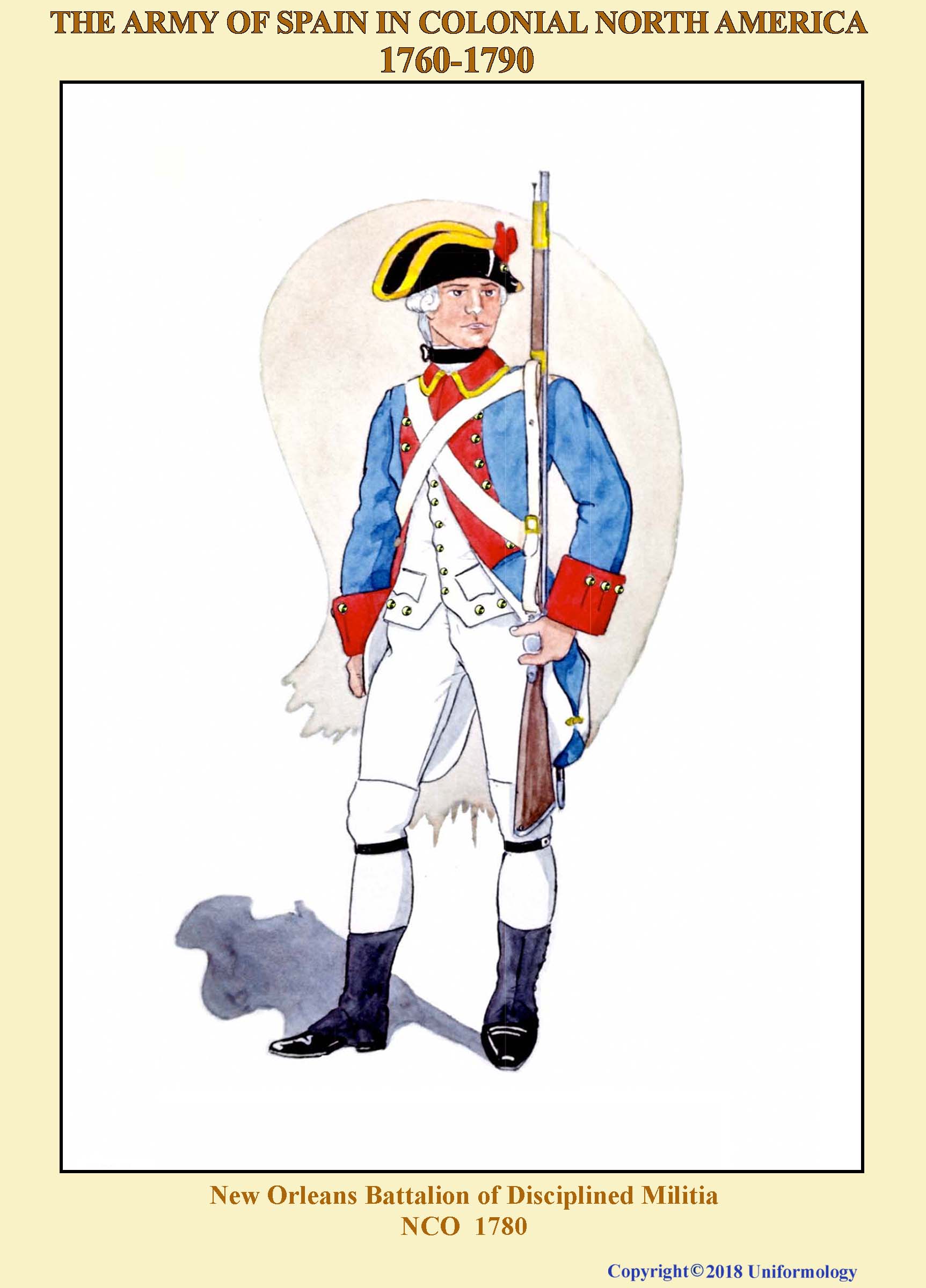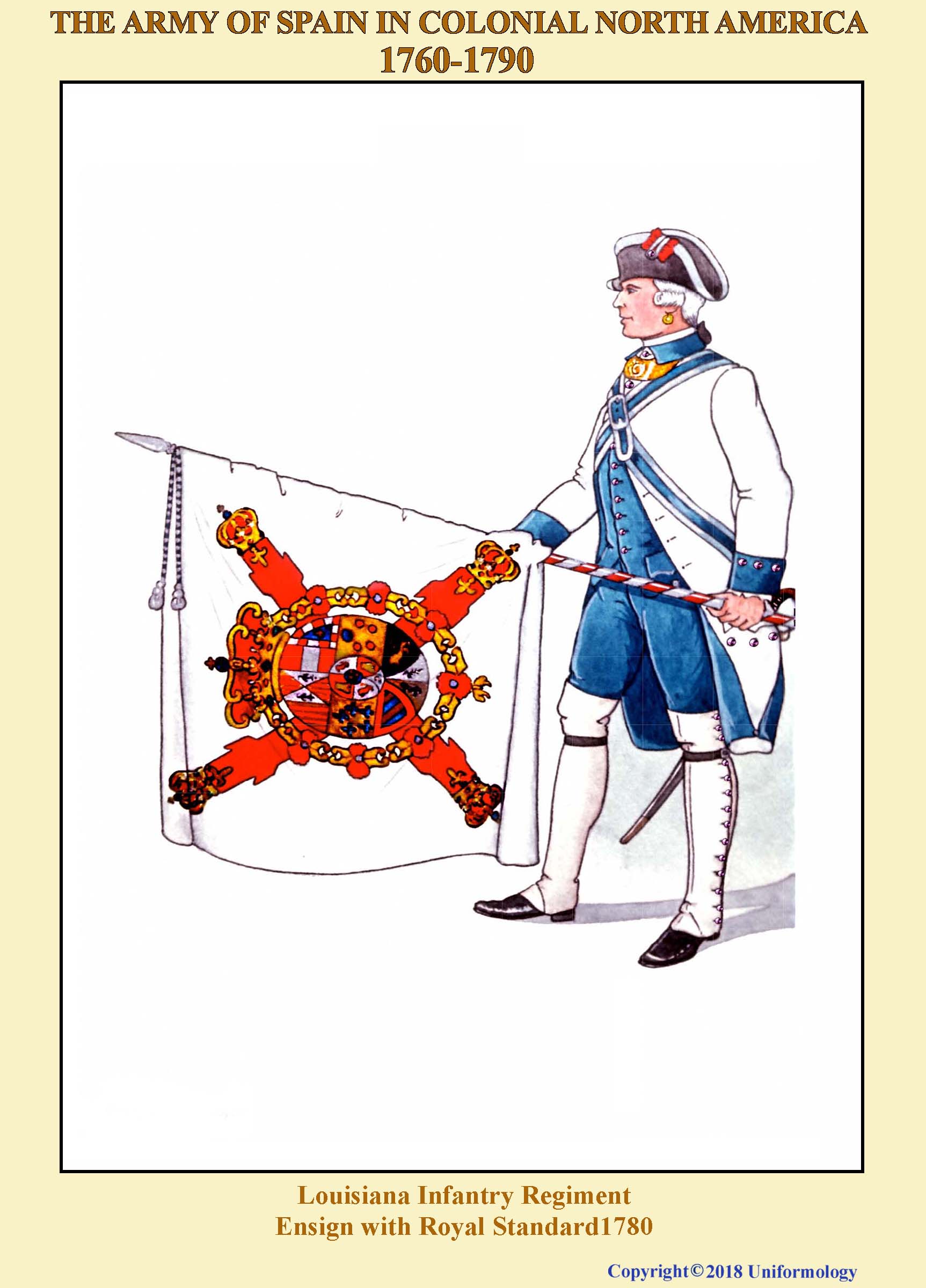THE WORLD OF MILITARY UNIFORMS
1660-1914
THE ARMY OF SPAIN
DURING THE AMERICAN REVOLUTION 1760-1786
Illustrations by By Lull
Page 1
ABOUT THE ARTIST
F.Lull is a Spanish Illustrator of the late 20th century. Little is known of his work. This set of illustrations were commissioned especially for this work alongside Bueno, a more famous Spanish artist who is featured later in this section.
THE ARMY OF SPAIN IN THE AMERICAN REVOLUTION
From the book by J. Sloan Cranz published by Uniformology in 2006
The Spanish involvement in the American Revolutionary War centers around one individual, Bernardo de Galvez. He first set foot in the western hemisphere as a member of his uncle Jose de Galvez Gallardo's entourage. The elder Galvez was there on an inspection tour of the viceroyalty of New Spain. Bernardo de Galvez was sent to take up the position of commandant of all military forces in the northern frontier of New Spain and there he fought many battles against the Apaches. From 1772 to1775 Galvez returned to Europe where he spent three years in France learning militaryscience, French language and culture.
Returning to Spain in 1775, Galvez served as captain of infantry under Alejandro O'Reilly, a future governor of Louisiana, in the Regiment of Seville. Pro moted to Lieutenant Colonel, in 1776 Galvez was sent to Louisiana where he was promoted to colonel of the Louisiana Regiment. Finally on January 1, 1777, he took over as governor of Louisiana. As governor Galvez was in more of a position to help out the American Patri ots against their British enemies. Long before Spain entered the war on America's side, Galvez was corresponding with influential Americans such as Patrick Henry and Thomas Jefferson. He ensured that no British ships could traverse the Mississippi or dock at the strategic port of New Orleans. Galvez was also one of many Spanish offi cials who arranged to have supplies including munitions find the embattled American troops.
June 21, 1779, marked the date that Spain formally declared war on Great Britain, and Galvez was ordered to gather troops to fight the British along the Mississippi and the Gulf Coast. Food was most important for any military campaign and Galvez arranged for beef to be gathered and herded from Spanish Texas for his troops. The beef was escorted by troops from the Presidio San Antonio de Bexar, Presidio La Bahia, and El Fuerte del Cibolo. Along with the troops, several hundred horses were also sent to help haul the supplies or function as cavalry. When he entered the field in the fall of 1779, Galvez had fourteen hundred men. They defeated British forces in numerous battles including Manchac, Baton Rouge, and Natchez. Two major victories for the Spanish against Great Britain occurred in March of 1780 at Mobile, and again the following year at Pensacola.
Reinforcements arrived from Cuba, Mexico and Puerto Rico to help in the Spanish campaigns on the Gulf Coast. Galvez employed much of his military knowledge when after a month Ion sie eon March 14, 1780 with a force of two thousand men both on land and sea, he took the British controlled Fort Charlotte at Mobile. Perhaps his greatest victory during the American Revolutionary War occurred a year later when he took Pensacola, then the British capital of West Florida. Galvez had seven thousand men under his command during this siege of Fort George, made up of men from all over the Spanish empire. These included free Blacks, Creoles, Ameri can Indians and Spaniards from Spain, Cuba, Mexico, Puerto Rico, Hispanola and even Venezuela. After two months on May 10, 1781, Fort George fell. A year later on May 8, 1782, Galvez was in charge of the Spanish forces that took the British naval base at New Providence in the Bahamas. Peace was declared and Galvez took part in the negotiations that helped draft the terms for the treaty and, the new American government cited him for his help.
Later Galvez was promoted to general and after a brief respite in Spain he returned to the Americas where he served as captain-general and governor of Cuba, and later he was appointed viceroy of New Spain succeeding his father.
Bernardo de Galvez died on November 30, 1786 leaving behind an accomplished career as a military officer and statesman. Jose de Evia, a mapmaker who was com missioned by Galvez to conduct a survey of the Gulf Coast, named the city of Galveston in his honor. Galvez's actions during the American Revolution are con sidered one of many reasons why the British lost the war.
The regular army that Galvez took into the field was not inexperienced. Many of the troops from the provinces were hardened by many years of campaigns against various Indian tribes. They were used to the hot climate and stresses of campaign in rugged territory. It should also be noted that during Spain's conquest of the New World many black slaves were brought to the territories. They were concentrated especial ly in Cuba and the costal regions of Mexico, Veracruz, in particular. While there is some controversy about the treatment of slaves in Spanish America being better than in the northern colonies free blacks and freed slaves were welcomed into the militias although in their own segregated regiments or battalions. Soldiers of mixed races even had their own groups.
SPANISH UNIFORMS
The Spanish Army of the late 18th Century followed closely the styles of European armies. The white coats were symbolic of Hapsburg and Bourbon armies. Facing colours appeared on collar and cuffs. In the infantry the headdress of the rank and file was the tricorne hat later a bicorne. Grenadiers of the Spanish infantry had a unique feature of their fur grenadier caps where the bag, in facing colour, at the rear fell down below the neck and was decorated with symbols in yellow or white lace. This feature would last until the end of the Napoleonic Wars.
Royal and foreign regiments such as Walloon and Irish regiments wore blue coats with red facings as did the Artillery and Marine regiments.
The cavalry consisted mostly of Dragoons and Horse. Dragoons generally wore yellow or green coats with facing colours on collar and cuffs. The headdress was similar to a grenadier cap with a plain front and rounded top edged with fur. The Horse regiments wore red or white coats with facings.
The Spanish Navy wore uniforms similar to navies around the world. excpet that they had scarlet facings. As with other navies, only officers wore uniform
GO TO PAGE 2

